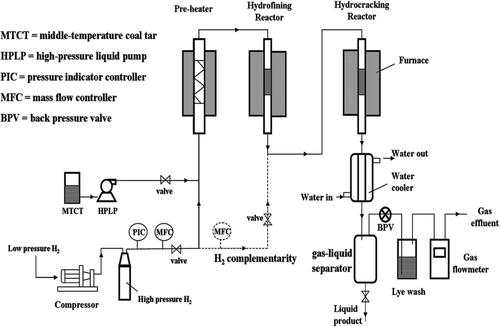Various usable energy sources are always the research focus concerning the petroleum depletion crisis and rising fuel prices. Coal tar are abundantly produced every year by coal carbonization and gasification but poorly used owing to its defects in physical and chemical properties.
Researchers with Institute of Process Engineering (IPE) developed an upgrading process for coal tar application as an energy fuel for combustion. They produced clean liquid fuel from the catalytic hydrogenation of coal tar using two serial fixed beds.
In their work, hydrofining (MoNi/γ-Al2O3) and hydrocracking (WNiP/γ-Al2O3–USY) catalysts with different metal loadings were prepared, which were filled in the first and second fixed beds, respectively, where hydrogenation of coal tar distillate used as feedstock was performed. The entire reaction system was mainly made up of three units (Figure 1), that is, the reactant feeding unit, the hydrogenation unit, as well as the product separation and collection unit.
Catalyst screening tests were performed under typical experimental conditions, that is, hydrogen pressure (PH2) of 8 MPa, liquid hourly space velocity (LHSV) of 0.8 h–1, hydrogen-to-coal tar volume ratio (H2/oil ratio) of 1600, hydrofining temperature in the first fixed bed (Thf) of 360 °C, and hydrocracking temperature in the second fixed bed (Thc) of 380 °C. Optimum combination of catalysts was finally determined. Gasoline (≤180 °C) and diesel (180–360 °C) fractions were separated from the effluent oil.
The effect of pressure (by 6-10 MPa) on the hydrogenation performance was also investigated. The catalysts showed good stability in activity in the test of catalyst life and XRD and TEM characterizations indicated promising results.
The analysis results of the products indicated that raw coal tar could be promisingly upgraded by catalytic hydrogenation. Gasoline fraction with low sulfur and nitrogen contents of 39 and 13 ppm and diesel fraction with 43 and 9 ppm were obtained, as compared to the respective values of 0.96 and 1.69 wt % in the feedstock. GC–MS analyses revealed that the gasoline and diesel products mainly comprised substituted cyclohexanes, substituted and partially saturated naphthalenes, and saturated paraffins. As compared to other previous studies, a relatively lower hydrogen pressure of 6 MPa was successfully applied to obtain good-quality products.
The authors thank the National Natural Science Foundation of China and the National Basic Research Program of China. The paper was published in ACS Publications.

Figure 1. Flow diagram of coal tar hydrogenation process (Image by IPE)
 Search
Search




 京公网安备110402500047号
京公网安备110402500047号